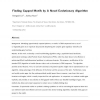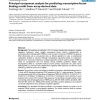ESORICS
2011
Springer
13 years 3 months ago
2011
Springer
The rapid progress of human genome studies leads to a strong demand of aggregate human DNA data (e.g, allele frequencies, test statistics, etc.), whose public dissemination, howeve...
BIBM
2010
IEEE
14 years 1 months ago
2010
IEEE
Recently, the concept of a species containing both core and distributed genes, known as the supra- or pangenome theory, has been introduced. In this paper, we aim to develop a new ...
MEDIAFORENSICS
2010
14 years 1 months ago
2010
A number of methods have been proposed over the last decade for embedding information within deoxyribonucleic acid (DNA). Since a DNA sequence is conceptually equivalent to a unid...
INFORMATICALT
2010
14 years 2 months ago
2010
The genetic information in cells is stored in DNA sequences, represented by a string of four letters, each corresponding to a definite type of nucleotides. Genomic DNA sequences a...
EVOW
2010
Springer
14 years 2 months ago
2010
Springer
Background: Identifying approximately repeated patterns, or motifs, in DNA sequences from a set of co-regulated genes is an important step towards deciphering the complex gene reg...
BMCBI
2002
14 years 3 months ago
2002
Background: Biologists are often interested in performing a simple database search to identify proteins or genes that contain a well-defined sequence pattern. Many databases do no...
BMCBI
2005
14 years 3 months ago
2005
Background: During the last few years, DNA sequence analysis has become one of the primary means of taxonomic identification of species, particularly so for species that are minut...
BMCBI
2005
14 years 3 months ago
2005
Background: The responses to interleukin 1 (IL-1) in human chondrocytes constitute a complex regulatory mechanism, where multiple transcription factors interact combinatorially to...
BMCBI
2005
14 years 3 months ago
2005
Background: Alignments of homologous DNA sequences are crucial for comparative genomics and phylogenetic analysis. However, multiple alignment represents a computationally difficu...
TCS
2008
14 years 3 months ago
2008
We address the problem of detecting consensus motifs, that occur with subtle variations, across multiple sequences. These are usually functional domains in DNA sequences such as t...








